广州五年级上册英语知识点
全新广州版五年级英语上册知识点汇总(全册 共9页)

全新广州版五年级英语上册知识点汇总(全册共9页)Module 1 HobbiesUnit 1 What’s your hobby?一、兴趣爱好的词组:1.play computer games玩电脑游戏2.play music玩音乐3. collect stamps 集邮4.keep pets养宠物5.make model ships做轮船模型6. read books读书7.take photos 照相8.make cakes做蛋糕9. plant trees种树10. grow flowers种花11.listen to music听音乐12. singing,唱歌13.dancing跳舞14.drawing画画15.play the piano弹钢琴16.play chess下棋17. play basketball 打篮球…二、课文短语:1.make model ships 做轮船模型2.love making 喜欢制作3.more than 20 ships 超过20艘轮船4.collect stamps 集邮5.keep pets 养宠物6. Three birds 三只鸟7.play music 玩音乐8. every day 每天9.read books 读书10. every night 每天晚上11.play computer games 玩电脑游戏12.about 50 games 大约50个游戏13.take photos 照相14.during my holiday 在我的假期里三、句型:1. What’s your hobby?2. Do you like…?Yes, I do. / No, I don’t.3. I love/like… I like/love dancing .4. I enjoy …I enjoy listening to music.5. My (favourite) hobby is …6. …is my (favourite) hobby.7. Is your hobby keeping pets? Yes, it’s. / No, it isn’t.Unit 2 His hobby is drawing一、课文短语:1.a great painter 一个伟大的画家2.draw cartoons 画漫画3.coloured pencils 彩色的铅笔4.his pet dog 他的宠物狗5.in the sky 在天空中6.birthday cards 生日卡片7.for his friends 给他的朋友们8.on their birthday 在他们的生日9.interesting people 有趣的人物10.beautiful places 美丽的风景11.in every room 在每一个房间12.in her house 在她的房子里二、句型:1. What’s Mike’s hobby?His hobby is …2. When does Mike usually draw? Mike通常在什么时候画画?He usually draws ….3. What does Mike give his friends for their birthday?4. What present does Amy give to Tom?5. What does she want to do when she grows up? She wants to be a writer.三、重点精析:1. grow up 成长,长大want to do…想要做…如:When Lucy grows up she wants to be an English teacher.当露丝长大后,她想成为一名英语教师。
广州版小学英语五年级上册英语

Un it12 Four SeaS OnSin One dayPart One重点讲解度 _________ 之前__________ 在外面____________ 改变 _________雨伞 _______ 完成 ________ 走路 _______________ 真实的 ______穿上 ________ 午餐时刻_________ 猛烈地;努力地________ 你的;你们的 ______我的第一天 _________________ 一些有趣的东西______________________很多衣服 __________________ 开始照耀________________________在午餐时间 _________________ 下大雨_________________________在某一天 __________________二、重点语法Today is my first day in LOndOn and I lear ned SOmeth ing in teresti ng about theWeather here.1)At ,in跟地点的差别:at+小地点in +大地点_________ home _____________ school _____________ G Uan gzhou_________ shop _____________ En gla nd __________ C hina_________ museum ___________ Beiji ng ___________ t he PIaygrO Und2)somethi ng in teresti ng—些有趣的东西SOmethi ng跟形容词连用时,形容词要后置。
一些冷的东西 __________________ 一些新的东西______________________一些可怕的东西 ___________________ 一些无聊的东西_____________________What' S the temperatureThe Weather report Said the temperature WaS only 16 .What' S the temperatu这是问答气温的常用句型。
教科版(广州)小学英语五年级上册模块重点归纳
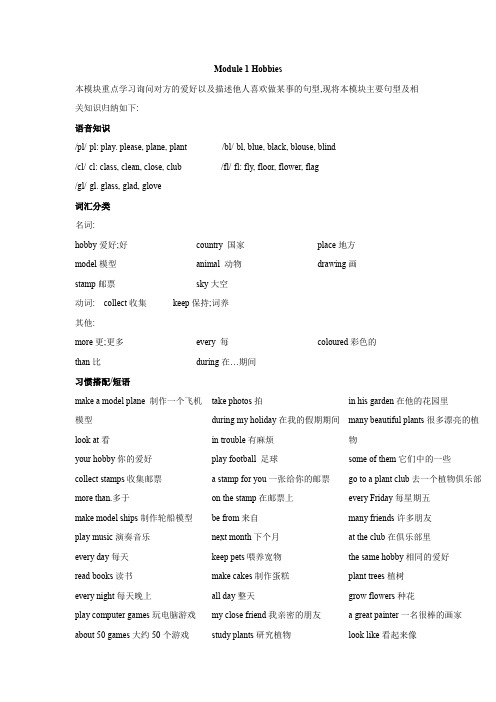
Module 1 Hobbies本模块重点学习询问对方的爱好以及描述他人喜欢做某事的句型,现将本模块主要句型及相关知识归纳如下:语音知识/pl/-pl: play. please, plane, plant /bl/-bl, blue, black, blouse, blind/cl/-cl: class, clean, close, club /fl/-fl: fly, floor, flower, flag/gl/-gl. glass, glad, glove词汇分类名词:hobby爱好;好model模型stamp邮票country 国家animal 动物sky大空place地方drawing画动词: collect收集keep保持;词养其他:more更;更多than比every 每during在…期间coloured彩色的习惯搭配/短语make a model plane 制作一个飞机模型look at看your hobby你的爱好collect stamps收集邮票more than.多于make model ships制作轮船模型play music演奏音乐every day每天read books读书every night每天晚上play computer games玩电脑游戏about 50 games大约50个游戏take photos拍during my holiday在我的假期期间in trouble有麻烦play football 足球a stamp for you一张给你的邮票on the stamp在邮票上be from来自next month下个月keep pets喂养宽物make cakes制作蛋糕all day整天my close friend我亲密的朋友study plants研究植物in his garden在他的花园里many beautiful plants很多漂亮的植物some of them它们中的一些go to a plant club去一个植物俱乐部every Friday每星期五many friends许多朋友at the club在俱乐部里the same hobby相同的爱好plant trees植树grow flowers种花a great painter一名很棒的画家look like看起来像draw cartoons画漫画draw animals画动物after school放学后in the sky在天空中birthday cards生日卡片beautiful places美丽的地方in every room在每一个房间里in her house在她家grow up长大write stories写故事play table tennis打乒乓球do some reading阅读very much很;非常put…on..把……放在…上in his bedroom在他的卧室里in the bag在袋子里as a hobby作为一项爱好惯用表达式Wow!哇! Thank you very much,非常感谢你。
广州版小学五年级上、下册英语知识点总结

广州版小学五年级英语知识点总结五年级上册共六个模块,18单元,209单词(四年级186个单词)五年级下册共六个模块,18单元,157单词(四年级172个单词)五年级上册知识点Module1 Routines and Dates学习重点1、掌握一月到十二月、四季的名称2、用英语说出日期日期的表示法有两种,如:“今天10月20日。
”a)先说月份:Today is October the twentieth (20th)b)先说日期:Today is the twentieth of October(20th)3、掌握节日的名称及日期。
(详见书本第13页)例如:New Year's Day( January 1st ) Women's Day( March 8th)4、能用英语说出学期的开始和结束The autumn term begins in September and ends in January.5. 掌握基数词和序数词,注意区分和运用重点掌握:first,second,third,fifth,ninth,twelfth,twentieth.基数词表示数量:three pandas三只熊猫。
序数词表示顺序:the second month第二个月6、注意表示时间频率的词:never、sometimes、often、usually、always,注意这些词在句子中的位置——除了“是”动词以外,他们都放在在动词的前面,如:(1)She often comes here . (2)She is always late .7、能用英语谈论日常的活动(能写一篇小作文)8、掌握时态:一般现在时的使用:(1)定义:一般现在时表示已形成习惯、规律的动作或状态。
(2)特征:通常句子中有often、usually、或sometimes等等。
(3)肯定句的结构:人称+动词:①其他人称(I、you、we、they、the boys……)+动词原形②第三人称单数(he、she、it、Tom、……)+动词“s/es”形式例句:The boys like TV plays. Sally likes TV plays.(4)一般疑问句:助动词(Do/Does)+人称+动词原形Do the boys like TV plays? Does the boy like TV plays?(5)否定句:人称+助动词否定形词(don’t/doesn’t)+动词原形The boys don’t like TV plays. The boy doesn’t like TV plays.(6)记住:助动词一出,后面动词用原形。
广州版英语五年级上册Unit1-Unit12知识点分析精简
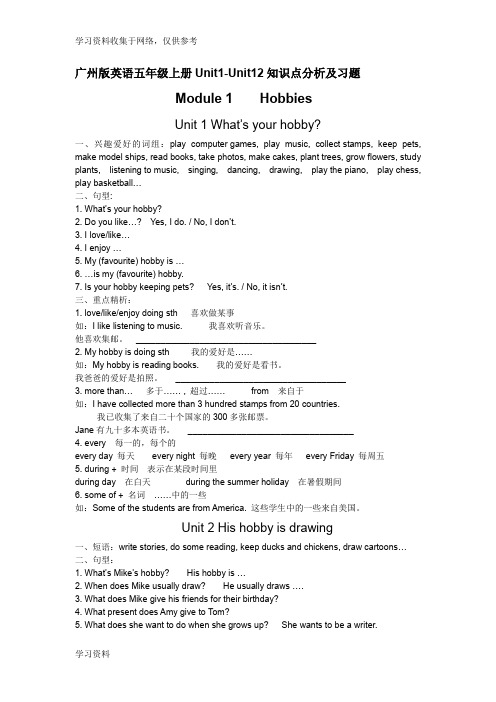
广州版英语五年级上册Unit1-Unit12知识点分析及习题Module 1 HobbiesUnit 1 What’s your hobby?一、兴趣爱好的词组:play computer games, play music, collect stamps, keep pets, make model ships, read books, take photos, make cakes, plant trees, grow flowers, study plants, listening to music, singing, dancing, drawing, play the piano, play chess, play basketball…二、句型:1. What’s your hobby?2. Do you like…?Yes, I do. / No, I don’t.3. I love/like…4. I enjoy …5. My (favourite) hobby is …6. …is my (favourite) hobby.7. Is your hobby keeping pets? Yes, it’s. / No, it isn’t.三、重点精析:1. love/like/enjoy doing sth 喜欢做某事如:I like listening to music. 我喜欢听音乐。
他喜欢集邮。
_____________________________________2. My hobby is doing sth 我的爱好是……如:My hobby is reading books. 我的爱好是看书。
我爸爸的爱好是拍照。
___________________________________3. more than… 多于…… , 超过……from 来自于如:I have collected more than 3 hundred stamps from 20 countries.我已收集了来自二十个国家的300多张邮票。
广州版英语五年级上册语法知识点总结
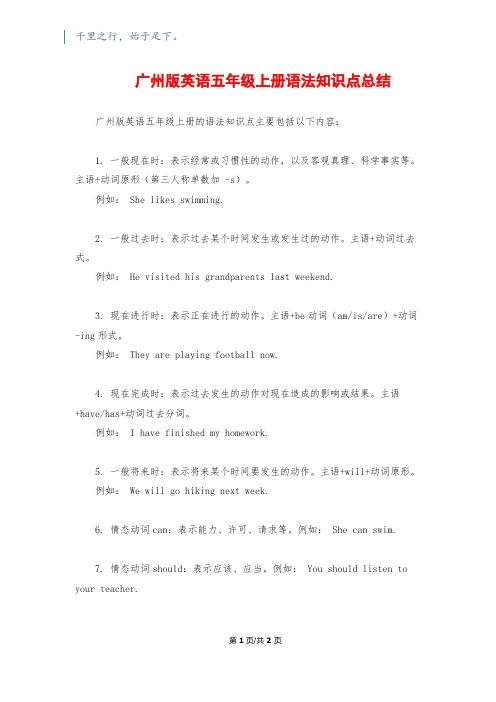
千里之行,始于足下。
广州版英语五年级上册语法知识点总结广州版英语五年级上册的语法知识点主要包括以下内容:1. 一般现在时:表示经常或习惯性的动作,以及客观真理、科学事实等。
主语+动词原形(第三人称单数加 -s)。
例如: She likes swimming.2. 一般过去时:表示过去某个时间发生或发生过的动作。
主语+动词过去式。
例如: He visited his grandparents last weekend.3. 现在进行时:表示正在进行的动作。
主语+be动词(am/is/are)+动词-ing形式。
例如: They are playing football now.4. 现在完成时:表示过去发生的动作对现在造成的影响或结果。
主语+have/has+动词过去分词。
例如: I have finished my homework.5. 一般将来时:表示将来某个时间要发生的动作。
主语+will+动词原形。
例如: We will go hiking next week.6. 情态动词can:表示能力、许可、请求等。
例如: She can swim.7. 情态动词should:表示应该、应当。
例如: You should listen to your teacher.第1页/共2页锲而不舍,金石可镂。
8. 基数词和序数词的用法。
例如: six cups,the first book。
9. 形容词的比较级和最高级形式。
例如: tall-taller-tallest,good-better-best。
10. 疑问词的用法。
例如: What's your favourite colour?11. 人称代词的主格和宾格。
例如: I like apples. Give it to me, please.12. 反意疑问句。
例如: You like Chinese food, don't you?13. 特殊疑问句。
广州版英语五年级上册语法知识点
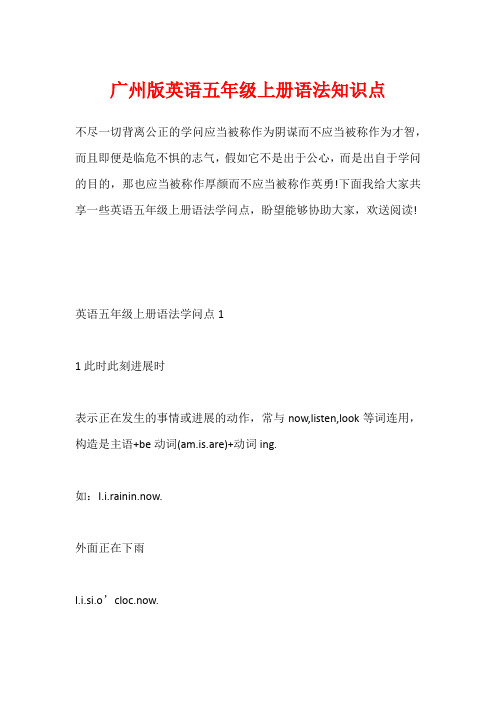
广州版英语五年级上册语法知识点不尽一切背离公正的学问应当被称作为阴谋而不应当被称作为才智,而且即便是临危不惧的志气,假如它不是出于公心,而是出自于学问的目的,那也应当被称作厚颜而不应当被称作英勇!下面我给大家共享一些英语五年级上册语法学问点,盼望能够协助大家,欢送阅读!英语五年级上册语法学问点11此时此刻进展时表示正在发生的事情或进展的动作,常与now,listen,look等词连用,构造是主语+be动词(am.is.are)+动词ing.如:I.i.rainin.now.外面正在下雨I.i.si.o’cloc.now.此时此刻6点了M.parent.ar.readin.newspaper.i.th.sittin.room.我父母正在客厅看报纸Look.Th.childre.ar.havin..runnin.rac.now.看!孩子们正在赛跑问句将be动词移前,否认句在be动词后+not.2一般此时此刻时表示经常反复发生的事情或动作,常与ually.sometimes.always.ever.day(wee.year….o.Sundays等词连用。
构造是主语+动词原形;当主语为第三人称单数即he,she.it.Tom.m.mother.th.boy等词时,动词后加s或es.如:W.hav.a.Englis.lesso.ever.day.我们每天都要上英语课D.th.boy.ru.faste.tha.th.girls.Yes.the.do.男孩比女孩跑的快吗?是的问句借助于do.does否认句借助于don’t.doesn’t,后面动词必须要复原。
3一般过去时表示发生在过去的事情或存在的状态,常与s..week.month.year.Monday.week end).thi.morning等词连用。
构造是主语+be动词的过去式(was.were)或主语+动词的过去式。
留意:be动词与动词过去式不行同时运用。
广州版小学英语五年级上册Unit3教案知识点与习题及现在进行时和情态动词

广州版小学英语五年级上册Unit3知识点与习题Step1 Unit 3词汇Step 2 Unit 3 句型1. I can swim very fast.2. What can you do? I can…3. Can he run fast? Yes, he can. No, he can’t.4. What are you good at?I’m good at drawing.Step 3 Unit 3 课文翻译Xiaoping: what’s your hobby,Mike?小玲:你的爱好是什么,迈克?Mike: Guess, I am very good at drawing.迈克:猜猜,我非常擅长画画。
Xiaoping: Your hobby is drawing cartoons.小玲:你的爱好是画卡通。
Mike: That’s right. I often draw cartoons with my cousin. She draws very well,too. What about you? 迈克:是的。
我经常和我得堂妹一起画卡通。
她也画得很好。
你呢?Xiaoping: I can swim very fast. My hobby is swimming.小玲:我游泳游得很快,我得爱好是游泳。
Ben: I love swimming too. Let’s go swimming together.本:我也喜欢游泳。
我们一起去游泳吧。
Step4 现在进行时定义:表示现在或现阶段正在进行或发生的动作或存在的状态。
构成:由be(am/is/are)+动词-ing形式构成标志性词语:现在进行时.通常用now,look,listen等词。
动词现在分词的构成规则现在进行时的用法(1)用来表示说话时正在进行或者发生的动作,(2)用来表示现阶段正在进行的动作(但说话时不一定在进行)现在进行时的句型变化1、肯定式结构:主语+be+动词-ing形式+其他.例如:We are running now.2、否定式结构:主语+be+not+动词-ing形式+其他.例如:They aren’t doing their homework.3、一般疑问句式结构:Be+主语+动词-ing形式+其他?例如:Is she having English lesson?回答:肯定Yes, she is. 否定:No,she isn’t.4、特殊疑问句式结构:疑问词+be+主语+其他?例如:What is he doing now?回答:He is swimming.现在进行时态练习题一.选择题1.Who _____ over there now?A.singingB. are singC. is singingD. sing2. It’s eight o’clock. The students _____ an English class.A.haveB. havingC. is havingD. are having3. Listen! The baby _____ in the next room.A.cryingB. criedC. is cryingD. cries4. Look! The twins _____ new sweaters.A.are wearingB. wearingC. are wearD. is wearing5. Don’t talk here. Grandparents _____.A.is sleepingB. are sleepingC. sleepingD.sleep6. listen! The girl________ a Russian song. She often________ it.A. sings;is singingB. sings; singsC. is singing; singsD. is singing; sing二.用现在进行时完成下列句子1.What _________ you __________ (do)?2.I _____________ (sing) an English song.3.It’s nine o’clock. My father___________(work) in the office.4.What are you _________(do) now? I ___________(eat) bread.5.______ you __________ (fly) a kite? Yes, _____________.6.______ she ___________ (sit) in the boat?7.______ you _____________ (ask) questions?8.We _______________ (play) games now.三.按要求改写句子1.The boy is playing basketball.否定句:____________________________一般疑问句:_________________________肯定回答:______________________否定回答:______________________Step 5 情态动词can情态动词有词义,表示语气的单词。
五年级英语上册1-4单元知识点归纳与练习题新广州版

2014五年级英语上册 1-4 单元知识点归纳与练习题(新广州版)dule 1 HobbUnit 1 What 's your hobby?一、兴趣爱好的词组: play computer games, play music, collect staake modelad books, taake cakes,plagrow flowers, study plants, listening to muging, dancing, drawing, plaano, plalay basketball…二、句型:What ' s your hobby?2. Do you like …? Yes, I do. / No, Idon 'I love/like …I enjoy …(favourite)(favourite) hobbIs your hobbgpets?三、重点精析: love/like/enjoy某事女口: I like listening to music.他喜欢集邮。
2. My hobby is doing sth 我的爱好是…… 女口: My hobby is reading books.我的爱好是看书。
我爸爸的爱好是拍照。
hobby is ........ is my 's. / N 't. doing sth 喜欢做 我喜欢听音乐__________________________________ a…多于 ...超过…… from 来自于如:I have collectedan 3 hundred stamps fro0 cou 我已收集了来自二十个国家的300 多张邮票。
Jane 有九十多本英语书。
_________________________________ very 每一的,每个的every day 每天every night 每晚every year 每年every Friday 每周五during + 时间表示在某段时间里during day 在白天during the summer holiday 在暑假期间+名词……中的一些如:udents aAmerica. 这些学生中的一些来自美国。
广州新编小学英语五年级上册知识点总结

U51.—Where is Ben ? Ben 在哪里?—He is at the swimming pool. 他在游泳池里。
2. He never goes swimming on weekdays. 他从不在工作日去游泳。
3. —Does Ben often go swimming? Ben经常去游泳吗?—Yes; he does. 是的;他经常去。
4.—Let me go and look for him there .我去那里找找他吧。
—OK. 好吧。
频率副词(never;seldom;sometimes;often;usually;always)U61. The Chen family is always very busy at the weekend.陈家人在周末总是很忙。
2. After breakfast Mrs Chen usually goes to themarket with Mr Chen.早餐后;陈太太常常和陈先生一起去市场。
3. Their son Jiamin always goes to the Children’sPalace on Saturday.他们的儿子Jiamin 周六总是去少年宫。
1. 一般现在时第三人称单数用法2. look for 和 find 区别U71.—What do you want to drink for lunch? 午餐你想喝什么—I want to have a cup of tea with milk.我想我要和一杯奶茶。
2.—Do you want coffee or tea? 你要咖啡还是茶?—I want coffee. 我要咖啡。
3—Can I have a large coke;please?请问;我能喝一个大杯的可乐吗—Sure.当然可以。
4.—Here you are.给你。
—Thanks a lot.多谢。
广州五年级上英语知识点

广州五年级上英语知识点广州的五年级英语课程通常遵循国家教育大纲,结合地方特色,为学生提供全面的英语学习体验。
以下是一些可能包含在五年级上学期英语课程中的知识点:1. 词汇积累:- 学习日常生活相关的词汇,如家庭成员、学校用品、食物、动物等。
- 掌握基本的形容词和动词,用以描述事物特征和行为。
2. 基本句型:- 学习并运用简单句型,如陈述句、疑问句、祈使句等。
- 练习使用“be动词”和助动词构成的句型。
3. 语法知识:- 掌握名词的单复数变化。
- 学习动词的时态,如现在进行时、一般现在时、一般过去时等。
4. 阅读理解:- 阅读并理解简单的英语短文,提取关键信息。
- 练习通过上下文推测生词的意思。
5. 口语交际:- 练习日常英语对话,如问候、自我介绍、询问和回答等。
- 学习使用礼貌用语和表达感谢。
6. 写作技能:- 练习写简单的句子和段落,如日记、书信等。
- 学习使用基本的连接词,使文章更加连贯。
7. 文化知识:- 了解英语国家的节日和习俗。
- 学习英语国家的一些基本地理和历史知识。
8. 综合运用:- 通过角色扮演、情景对话等活动,将所学知识综合运用到实际语境中。
- 完成一些简单的英语项目,如制作海报、编写小故事等。
9. 学习策略:- 学习有效的记忆词汇的方法,如联想记忆、分类记忆等。
- 培养自主学习的习惯,如定期复习、主动查阅资料等。
通过这些知识点的学习,学生不仅能够提高英语语言技能,还能培养跨文化交流的意识和能力。
同时,教师应鼓励学生积极参与课堂活动,通过实践来巩固所学知识。
希望这些内容对广州五年级的学生有所帮助。
五年级上册广州版英语知识梳理
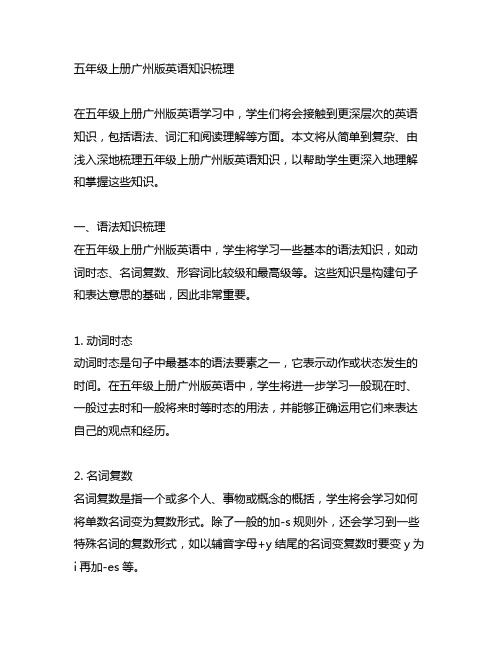
五年级上册广州版英语知识梳理在五年级上册广州版英语学习中,学生们将会接触到更深层次的英语知识,包括语法、词汇和阅读理解等方面。
本文将从简单到复杂、由浅入深地梳理五年级上册广州版英语知识,以帮助学生更深入地理解和掌握这些知识。
一、语法知识梳理在五年级上册广州版英语中,学生将学习一些基本的语法知识,如动词时态、名词复数、形容词比较级和最高级等。
这些知识是构建句子和表达意思的基础,因此非常重要。
1. 动词时态动词时态是句子中最基本的语法要素之一,它表示动作或状态发生的时间。
在五年级上册广州版英语中,学生将进一步学习一般现在时、一般过去时和一般将来时等时态的用法,并能够正确运用它们来表达自己的观点和经历。
2. 名词复数名词复数是指一个或多个人、事物或概念的概括,学生将会学习如何将单数名词变为复数形式。
除了一般的加-s规则外,还会学习到一些特殊名词的复数形式,如以辅音字母+y结尾的名词变复数时要变y为i再加-es等。
3. 形容词比较级和最高级形容词的比较级和最高级是用来比较人或事物的质量、性质或程度的。
在五年级上册广州版英语中,学生将学习如何构成形容词的比较级和最高级,以及它们在句子中的用法。
二、词汇梳理除了语法知识外,词汇也是英语学习中不可或缺的一部分。
在五年级上册广州版英语中,学生将学习一些常用的词汇,并掌握它们的用法和意思。
1. 学校生活在学校生活这一单元中,学生将学习一些有关学校活动、课程和规则的词汇,如classroom、music、library等,以便能够描述自己的学校生活和表达自己的观点。
2. 假期活动在假期活动这一单元中,学生将学习一些有关假期活动和旅行的词汇,如beach、mountain、picnic等,以便能够描述自己的假期生活和表达自己的感受。
3. 季节天气在季节天气这一单元中,学生将学习一些有关季节和天气的词汇,如spring、summer、autumn、winter等,以便能够描述季节变化和天气情况。
广州版小学五年级英语上复习归纳

业邸一2毎日秦海OU" J8UB J8q;86o; Xe|d s < 21(些N……丑)J9UB^^WW J8UU!P 引°Qq spuEU JnoX qse/v\(JBN ……丑)9Jopqjeye(aiojeq ・ \■no人”ue屮'eu!j uu< |一一乙noA eje MOH一-■pue>|ee/v\ AjeAe neqpoj Ae|d |—c neqpoj Ae|d noA op ueyoMOH—d33|se ||ej 2N。
屮4nsssaqo Xe|d Suipesj 8luos op S8SSB|6」B8Mdn用6 ssep」aye Buiddoqs 068SI0J8X8 羽印looqos o; 06e」0j 06 ”」0M o; 06:WML 3|npo|/\| 2. 一般现在时一般现在时表示:苗耿里舉谐’ ww^w^1蚩N年舉1. 经常发生的动作或存在状态,常和always (总是)usually (通常),often (经常),sometimes (有时候)everyday (每天),every week (每周)等时间状语连用。
2. 表示普遍真理一、陈述句:肯定句:《主语+ be动词〜》1. I am a teacher. 我是老师2. My birthday is on October 1st我的生日在十月一日《主语+动词〜》I ofte n play football on Sun days. 我经常在周日踢足球。
<第三人称单数+动词-s或-es.>She likes summer. 她喜欢夏天否定句:1,主语+ be动词+ n ot〜You are not a stude nt.你不是学生2,主语+ do not +动词〜I don ' t go to school every day.我每天不去上学<第三人称单数+ does not+动词〜> She doesn ' go shopp ing on Saturdays.她在周六不购物。
广州英语五年级知识点
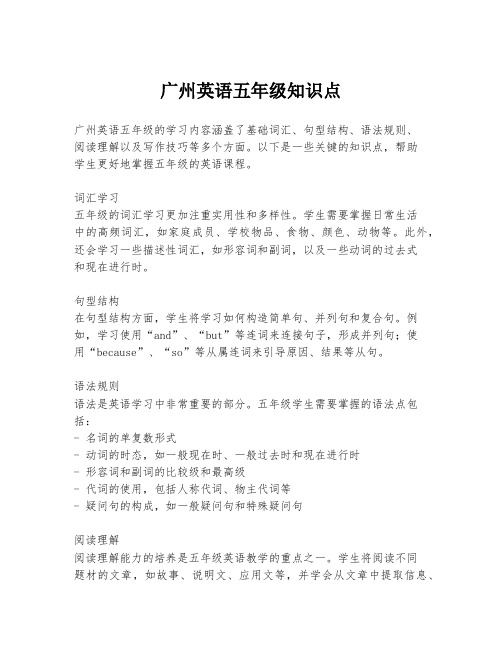
广州英语五年级知识点广州英语五年级的学习内容涵盖了基础词汇、句型结构、语法规则、阅读理解以及写作技巧等多个方面。
以下是一些关键的知识点,帮助学生更好地掌握五年级的英语课程。
词汇学习五年级的词汇学习更加注重实用性和多样性。
学生需要掌握日常生活中的高频词汇,如家庭成员、学校物品、食物、颜色、动物等。
此外,还会学习一些描述性词汇,如形容词和副词,以及一些动词的过去式和现在进行时。
句型结构在句型结构方面,学生将学习如何构造简单句、并列句和复合句。
例如,学习使用“and”、“but”等连词来连接句子,形成并列句;使用“because”、“so”等从属连词来引导原因、结果等从句。
语法规则语法是英语学习中非常重要的部分。
五年级学生需要掌握的语法点包括:- 名词的单复数形式- 动词的时态,如一般现在时、一般过去时和现在进行时- 形容词和副词的比较级和最高级- 代词的使用,包括人称代词、物主代词等- 疑问句的构成,如一般疑问句和特殊疑问句阅读理解阅读理解能力的培养是五年级英语教学的重点之一。
学生将阅读不同题材的文章,如故事、说明文、应用文等,并学会从文章中提取信息、理解主旨大意以及做出推理判断。
写作技巧写作是表达思想的重要方式。
五年级学生将学习如何写日记、书信、故事等不同类型的文章。
在写作过程中,学生需要学会如何组织文章结构,使用恰当的时态和语态,以及如何进行有效的段落划分。
听力训练听力是语言学习中不可或缺的一部分。
学生将通过听英语故事、对话、歌曲等来提高听力理解能力。
同时,听力练习也有助于学生更好地掌握语音和语调。
口语表达口语能力的培养同样重要。
学生将通过角色扮演、小组讨论、演讲等活动来锻炼口语表达能力。
此外,学生还需要学会在不同场合使用恰当的语言和表达方式。
总结五年级的英语学习是一个全面提升的过程,不仅需要掌握基础知识,还要培养听说读写的综合能力。
通过不断的练习和应用,学生可以逐步提高英语水平,为将来的深入学习打下坚实的基础。
广州版小学五年级英语上册1-12单元知识点归纳与习题
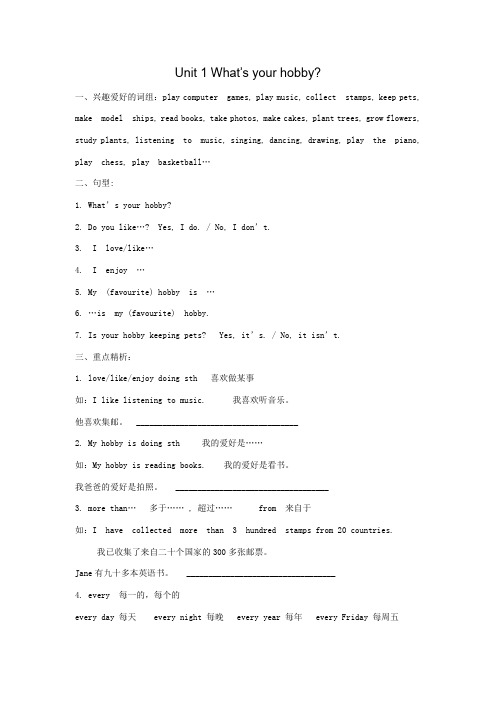
Unit 1 What’s your hobby?一、兴趣爱好的词组:play computer games, play music, collect stamps, keep pets, make model ships, read books, take photos, make cakes, plant trees, grow flowers, study plants, listening to music, singing, dancing, drawing, play the piano, play chess, play basketball…二、句型:1. What’s your hobby?2. Do you like…? Yes, I do. / No, I don’t.3. I love/like…4. I enjoy …5. My (favourite) hobby is …6. …is my (favourite) hobby.7. Is your hobby keeping pets? Yes, it’s. / No, it isn’t.三、重点精析:1. love/like/enjoy doing sth 喜欢做某事如:I like listening to music. 我喜欢听音乐。
他喜欢集邮。
_____________________________________2. My hobby is doing sth 我的爱好是……如:My hobby is reading books. 我的爱好是看书。
我爸爸的爱好是拍照。
___________________________________3. mo re than… 多于…… , 超过…… from 来自于如:I have collected more than 3 hundred stamps from 20 countries.我已收集了来自二十个国家的300多张邮票。
广州五年级英语上册各单元知识点归纳
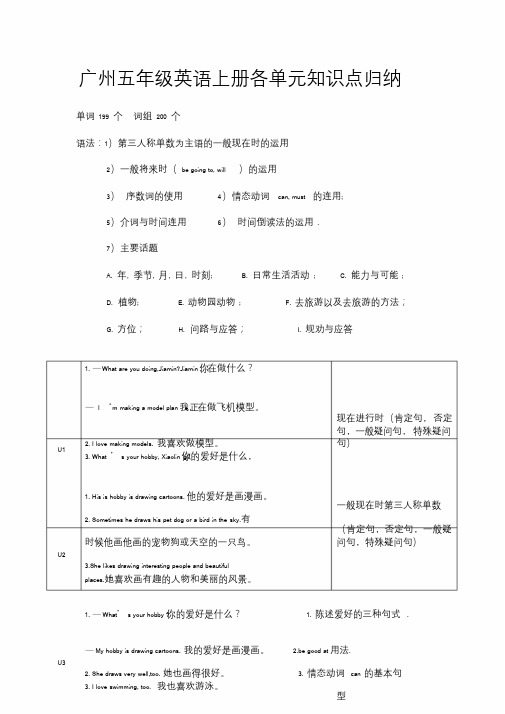
广州五年级英语上册各单元知识点归纳单词199 个词组200 个语法:1)第三人称单数为主语的一般现在时的运用2)一般将来时(be going to, will )的运用3)序数词的使用4)情态动词can, must 的连用;5)介词与时间连用6)时间倒读法的运用.7)主要话题A. 年, 季节, 月, 日, 时刻;B. 日常生活活动;C. 能力与可能;D. 植物;E. 动物园动物;F. 去旅游以及去旅游的方法;G. 方位;H. 问路与应答;I. 规劝与应答1. —What are you doing,Jiamin?Jiamin你,在做什么?—I ‘m making a model plan我e正.在做飞机模型。
现在进行时(肯定句,否定句,一般疑问句,特殊疑问U1 2. I love making models. 我喜欢做模型。
3. What ’s your hobby, Xiaolin你g?的爱好是什么,句)1. His is hobby is drawing cartoons. 他的爱好是画漫画。
一般现在时第三人称单数2. Sometimes he draws his pet dog or a bird in the sky.有(肯定句,否定句,一般疑时候他画他画的宠物狗或天空的一只鸟。
问句,特殊疑问句)U23.She likes drawing interesting people and beautifulplaces.她喜欢画有趣的人物和美丽的风景。
1. —What’s your hobby ?你的爱好是什么? 1. 陈述爱好的三种句式.—My hobby is drawing cartoons. 我的爱好是画漫画。
2.be good at 用法.U32. She draws very well,too. 她也画得很好。
3. 情态动词can 的基本句3. I love swimming, too. 我也喜欢游泳。
Unit2Hishobbyisdrawing知识点总结练习(讲义)教科版(广州)英语五年级上册

五上Unit2知识点总结一、Unit2重点单词【名词n.】sky [skaɪ]天空drawing ['drɔː(r)ɪŋ] 图画painter [ˈpeɪntə] 画家place [pleɪs]地方【动词v.】draw [drɔː] 画take [teɪk] 拿;取write [raɪt] 写【形容词adj.】coloured['kʌləd] 彩色的【短语】draw cartoons 画漫画coloured pencils 彩色铅笔in the sky 在天空中birthday cards生日卡片write stories写故事play table tennis打乒乓球do some reading读书keep ducks and chickens养鸡鸭interesting people 有趣的人们beautiful places美丽的地方in every room在每一个房间grow up长大二、Unit2重点知识点1.描写爱好的句型①one’s hobby is...=...is one’s hobbyHis hobby is writing stories.Writing stories is his hobby. 他的爱好是写故事。
②like/love/enjoy+vingHe likes writing stories.他喜爱写故事。
2. 描写愿望句型When Lucy grows up,she wants to be a painter.当露丝长大后,她想成为一名画家。
When I grow up, I want to be a painter.当我长大后,我想成为一名画家。
3. very much 非常,很,十分Janent loves collecting stamps very much.Janent很喜欢收集邮票。
4. will+动词原形(一般将来时态)He will draw birthday cards for his friends on their birthday.他将在朋友们生日的时候给他们画生日卡片。
- 1、下载文档前请自行甄别文档内容的完整性,平台不提供额外的编辑、内容补充、找答案等附加服务。
- 2、"仅部分预览"的文档,不可在线预览部分如存在完整性等问题,可反馈申请退款(可完整预览的文档不适用该条件!)。
- 3、如文档侵犯您的权益,请联系客服反馈,我们会尽快为您处理(人工客服工作时间:9:00-18:30)。
广州五年级上册英语知识点
Module1 Routines and Dates
学习要点
1、掌握一月到十二月、四时的名称
2、用英语说出日期
日期的表示法有两种 , 如:“今日 10 月 20 日。
”
先说月份: Today is October the twentieth( 20th )
先说日期: Today is the twentieth of October(20th )
掌握节日的名称及日期。
(详见书籍第13 页)
比如: New Year's Day( January 1st ) Women's Day( March 8th)
4、能用英语说出学期的开始和结束
The autumn term begins in September and ends in January.
5.掌握基数词和序数词 , 注意划分和运用
要点掌握: first,second,third,fifth,ninth,twelfth,twentieth.
基数词表示数目: three pandas 三只熊猫。
序数词表示次序: the second month 第二个月
6、注意表示时间频次的词:never 、sometimes、 often 、usually 、always, 注
意这些词在句子中的地点——除了“是”动词之外, 他们都放在在动词的前面, 如:(1) She here . ( 2) She is always late .
7、能用英语讨论平时的活动(能写一篇小作文)
8、掌握时态:一般此刻时的使用:
(1)定义:一般此刻时表示已形成习惯、规律的动作或状态。
(2)特点:往常句子中有 often 、usually 、或 sometimes 等等。
(3)一定句的构造:
人称 +动词:
①其余人称( I 、you、we、they 、the boys ⋯⋯) +原形
②第三人称数( he、she、 it 、Tom、⋯⋯) +“ s/es ”形式例句: The
boys like TV plays. Sally likes TV plays.
(4)一般疑句:助( Do/Does) +人称 +原形
Do the boys like TV plays? Does the boy like TV plays?
(5)否认句:人称 +助否认形( don’t/doesn ’t ) +原形
The boys don ’t like TV plays. The boy doesn’t like TV plays.
( 6)住:助一出 , 后边用原形。
Module2 Abilities
学要点
1、能用英人或物的能力(能干什么)
I can speak English. The monkey can climb trees.
2、能用英出 15 种以上的物名称。
3、句子有“ can”的候 , 无人称是 , 一般在的在一定句, 否认句或一般疑句一律用原形 , 如:
I/You/He/They/My mother can sing. Can you/he/they/my mother sing?
I/You/He/They/My mother can’t sing.
4、注意“ everyone ”作数用 : Everyone is here. Everyone likes
flowers.
5、注意“ not ⋯at all”的使用:
He can’t skate at all .=He can not skate at all.
He doesn’t like it at all .=He does not like it at all.
Module 3 Plants
学要点
1、能用英出一些植物(花, 木)的名称 , 并能写出十个以上相关植物的 , 并写上中
文。
2、注意 must 和 mustn’t的使用
( 1) must 必 mustn’t严禁、不允
( 2)must/ mustn ’t后边的用原形 ,
比如: I must go我必走了。
We mustn’t pick flowers in the park.我不可以在公园里在摘花。
3、掌握 Can 开表示求的句子的回答。
如: ---Can I go with you? ---Sure./ Of course you can.
Module4 Travel
学要点
1、能出十种以上的平时交通工具, 并写上中文。
2、注意使用交通工具的表示方法。
by( 乘坐 ):by bus/by train/by spaceship等, on foot(步行、走路)
3、的表达方有两种 ,
一种是直接表达法 , 直接依据“小 +分”的序出 ,7:15-seven fifteen 7:30-
seven thirty
第二种是逆法 , 基本依据“分 +小” 序出 , 如 :
①用 past( 在半小以内 , 包含半小 ), 如:
7:10-ten past seven 6:15-a quarter past six 9:25-twenty five past
nine
②半小用 half past,如 : 7:30-half past seven
③用 to( 超半小 ). 作“相差的分 +to+ 下一个小” , 如 : 7:45-a
quarter to eight
4、介的使用 in 、 on、at在前的用法 .
at- 详细几点 , 如: at five o'clock(用法: at the weekend)
on- 详细某一天 , 礼拜、日期前用 , 如 : on Sunday,on May 1st, on weekdays
in- 清晨、下午、夜晚 ,如:in the morning /in the afternoon /in the
evening in- 年份、月份、季前使用 , 如: in November 月份 in winter季in 2005 年份
5. 掌握:一般未来:表示将要生的事情 .
1)⋯ be ( is \ am \are) going to ⋯原形 .
比如 : 表示某人将要去游泳
am are going to swim. She is going to swim.
Igoing to swim. You
2)⋯ Will ⋯ + 原形 .
比如 : 表示某人将要去游泳
I will swim. You will swim. She will swim.
Module 5 Zoo Animals
学要点
1、能用英出十五种以上物的名称, 并写上中文。
2、能用英出一些地方(如各大洲)的名称, 并知道它的地点。
3、当我想要提出求或征意的候, 我能够用“ Would you like to +原形”的构
Would you like to go shopping with me?
Would you like to water the flowers?
Would you like to have lunch with my family?
回答: Yes, I ’d love to./ Yes, of course.
当你看到不良行为时 , 能用英语进行劝说 , 请写出 5 个以上。
(详见书籍61 页和90页)
比如: Don't kill us. Don't wake up a lion.
Module 6 Directions
学习要点
1、能用英语说出一些公共建筑物和学校建筑的名称。
2、能用英语问路 , 如:
1)Where is the canteen, please? 2)Could you tell me the way to the canteen, please?
3)Could you tell me how to get to the canteen, please? 4)How do I get to the canteen, please?
5)Is the canteen near here? 6)Is the zoo on the right or on the
left?
3、能用英语回答某地的地点, 并记着以下的一些表达方式:
turn right out of the hotel在旅馆外面on the left / right在左侧/
在右侧
turn left / right转左/转右go straight ahead向来往前走
take the second left在第二个拐弯处左拐take a No.216 bus乘坐216号公共汽车
4、注意咨询他人或致谢的礼貌用语, 如:
Thank you very much./ Thanks a lot.
./ Not at all.
(2) Excuse me. (用于打搅他人的时候。
)。
